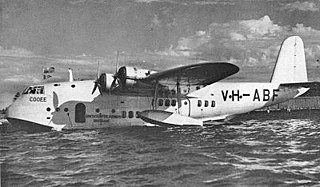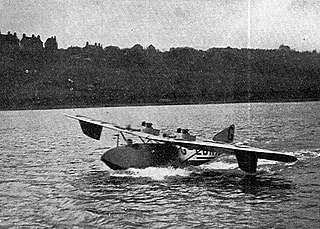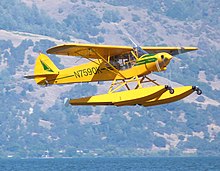
A flying boat is a type of fixed-winged seaplane with a hull, allowing it to land on water. It differs from a floatplane in having a fuselage that is purpose-designed for flotation, while floatplanes rely on fuselage-mounted floats for buoyancy.

A seaplane is a powered fixed-wing aircraft capable of taking off and landing (alighting) on water. Seaplanes are usually divided into two categories based on their technological characteristics: floatplanes and flying boats; the latter are generally far larger and can carry far more. Seaplanes that can also take off and land on airfields are in a subclass called amphibious aircraft, or amphibians. Seaplanes were sometimes called hydroplanes, but currently this term applies instead to motor-powered watercraft that use the technique of hydrodynamic lift to skim the surface of water when running at speed.

An amphibious aircraft or amphibian is an aircraft that can take off and land on both solid ground and water. They are typically fixed-wing, though amphibious helicopters do exist as well. Fixed-wing amphibious aircraft are seaplanes which are equipped with retractable wheels, at the expense of extra weight and complexity, plus diminished range and fuel economy compared to planes designed specifically for land-only or water-only operation. Some amphibians are fitted with reinforced keels which act as skis, allowing them to land on snow or ice with their wheels up.

Landing gear is the undercarriage of an aircraft or spacecraft that is used for taxiing, takeoff or landing. For aircraft it is generally needed for both. It was also formerly called alighting gear by some manufacturers, such as the Glenn L. Martin Company. For aircraft, Stinton makes the terminology distinction undercarriage (British) = landing gear (US).

The Blackburn B-20 was an experimental aircraft, first flying in 1940, that attempted to drastically increase the performance of flying boat designs. Blackburn Aircraft undertook an independent design study based on a patent filed by their chief designer, John Douglas Rennie for a retractable pontoon float that formed the planing hull.

The Albatros W.4 was a military floatplane designed and produced by the German aircraft manufacturer Albatros Flugzeugwerke.

The Supermarine Seagull was a flying boat produced by the British aircraft manufacturer Supermarine. It was developed by Supermarine's chief designer R.J. Mitchell from the experimental Supermarine Seal II.
The Groupe Latécoère is an aircraft company based in Toulouse, France. Founded by the aeronautics pioneer Pierre-Georges Latécoère during 1917, the company became well known in its first few decades for its range of seaplanes, such as the six-engined Latécoère 631.

The Sopwith Admiralty Type 860 was a 1910s British biplane seaplane torpedo bomber designed and built for the Admiralty by the Sopwith Aviation Company.

The Gotha WD.7 was a twin-engine maritime patrol floatplane developed during World War I by Gothaer Waggonfabrik (Gotha) for the Imperial German Navy's Naval Air Service. The prototype was captured by the French on its first combat mission in April 1916 after it was forced to make an emergency landing after an engine failed. Despite this seven additional WD.7s were ordered and were used for training torpedo bomber pilots and for trials. Only a single aircraft is known to have survived the war.

The Short Type 827 was a 1910s British two-seat reconnaissance floatplane. It was also known as the Short Admiralty Type 827.

The Short Type 166 was a 1910s British two-seat reconnaissance, bombing and torpedo-carrying folder seaplane, designed by Short Brothers.

The Blackburn Pellet was a single-engined, single-seater biplane flying boat designed as a contender for the 1923 Schneider Trophy competition. It was destroyed while taking off for the trials of the contest.

Floats are airtight hollow structures, similar to pressure vessels, designed to provide buoyancy in water. Their principal applications are in watercraft hulls, aircraft floats, floating piers, pontoon rhinos, pontoon causeways, and marine engineering applications such as salvage.

The Short S.1 Cockle was a single-seat sport monoplane flying boat, with a novel monocoque duralumin hull. It was underpowered and so did not leave the water easily, but it proved that watertight and corrosion-resistant hulls could be built from metal.

The Short S.41 was a British single-engined biplane built for the Royal Navy in 1912. Capable of being operated either on wheels or floats, it was successful enough for a further two similar aircraft to be built, with the type remaining in use until the early years of the First World War.

The Beeson MB.26 was a French sesquiplane floatplane designed by Marcel Besson as a shipborne two-seat reconnaissance aircraft for the French Navy, but it was not ordered into production.

The Vought XSO2U was an American observation floatplane developed by Vought-Sikorsky for the United States Navy during the late 1930s. Intended to replace the Curtiss SOC Seagull in service as a scout aboard cruisers, it proved superior to the Curtiss SO3C in evaluation, but failed to win a production contract due to Vought's lack of manufacturing capacity.
The Sopwith Special torpedo seaplane Type C was the first British aircraft designed to drop torpedoes. A single-engine biplane floatplane, it flew in July 1914 but proved unable to lift the design load and was soon abandoned.



















